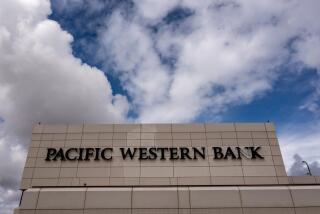THE TIMES 100 : The Best Performing Companies in California : The Bottom Line : The Best and Worst of Times for Banks and Thrifts : The parent of Pacific Western Bank finishes first on list of return on assets.
- Share via
Despite the turmoil in the banking and thrift industries, California’s major institutions turned in respectable, although mostly unspectacular, results for 1990.
Except for savings and loans that posted losses, California’s major banks and thrifts were profitable. Finishing at the top was Pacific Western Bancshares, a medium-sized banking company in San Jose that has been solidly profitable in recent years and which posted an enviable 1.52% return on average assets in 1990.
That means the firm, parent of Pacific Western Bank, earned $1.52 for every $100 in loans and other assets. Return on assets is considered a key indicator of profitability, and a figure above 1% is considered strong.
(The return on asset figure on The Times’ list may differ from those disclosed by the institutions themselves, because MZ computes them by averaging the figures for previous year-end assets and the current year-end assets, and dividing that by income. The figure thus reflects profit earned on a constantly growing asset base.)
Pacific Western, parent of Pacific Western Bank, was formed through the 1987 merger of Pacific Valley Bank in San Jose and County Bank & Trust in Santa Cruz. Last year, the bank finished second in profitability in The Times’ list of financial institutions.
The bank has benefited by the strong economy during the past few years in the Silicon Valley area. But Chairman Phillip R. Boyce also credited cost savings from the mergers, as well as a sophisticated management information system that helps executives manage the bank almost as if it were a manufacturer.
“We manage by lines of business, allocating profits, expenses and resources to those business lines that make us the better returns,” Boyce said.
Right now, the main source of profit is commercial lending to small and medium-sized businesses, often run by their owners and their families. The bank’s typical loan size is $3 million to $4 million, with the highest loans up to $10 million. Boyce said the bank’s real estate lending typically involves home builders that the bank knows well rather than riskier office projects.
Slipping on the list was the parent of City National Bank in Beverly Hills, long regarded as one of the state’s best managed mid-size banks.
City National, which had finished at the top in return on assets for two years straight, finished seventh in the latest survey, with a return on assets of 0.91%. Although down from a year earlier, it is still considered a decent return. City National has been hurt by an increase in non-performing real estate and commercial loans, which are loans at least 90 days past due or where collection is in doubt.
Among the largest banks, Wells Fargo & Co. again ranked first with a return on assets of 1.36%. The San Francisco bank has consistently been one of the most profitable banks in the nation, despite concerns that it may have too much exposure to risky real estate and corporate buyout loans.
BankAmerica’s return on assets in The Times 100 was 0.84%. That figure--which differs from the more widely published results for the bank--is based on net income of $877 million, which does not take into account tax credits that BankAmerica enjoyed last year. With those credits, the bank earned $1.1 billion, which would put its return on assets at 1.04%.
Two Japanese-controlled banks, Sumitomo and Union Bank, both in San Francisco, ranked toward among the top six, Sumitomo’s return was 0.98% of assets, while Union, which is controlled by Bank of Tokyo, was 0.92%.
Thrifts, in general, posted lower results. Many spent much of 1990 cleaning house, dealing with problem commercial real estate loans and selling off unwanted assets. Some, such as Great Western Financial in Beverly Hills, were active acquirers of failed thrifts and spent much of the year incurring expenses that come from digesting those acquisitions.
Downey Savings & Loan stood out with a return of 1.02%, the only thrift with a return on average assets greater than 1%. Downey was a major builder of neighborhood shopping centers until federal thrift laws were changed to get thrifts out of the development business. It now relys on its basic savings and loan business.
Other standouts were Firstfed Financial Corp. in Santa Monica and Golden West Financial, the Oakland-based parent of World Savings & Loan.
CalFed Inc. in Los Angeles posted the worst return, a -0.88%. The thrift, parent of California Bank, has been undergoing a restructuring that includes selling unneeded assets and writing down the value of commercial real estate projects.
TOP 25 BANKS AND S&LS;
Ranked by income as a percent of average assets. Computed by averaging previous year-end assets and the current year-end assets, and dividing that by income.
% return on average 1990 income Rank Company assets ($ millions) 1 Pacific Western Bancshares** 1.52 16.8 2 Wells Fargo & Co. 1.36 711.5 3 Downey Savings & Loan Assn. 1.02 42.0 4 Sumitomo .98 44.9 5 Firstfed Financial Corp. 0.96 27.1 6 Union Bank 0.92 146.5 7 City National Corp. 0.91 44.0 8 Golden West Financial Corp. 0.86 181.5 9 BankAmerica Corp. 0.84 877.0 10 Westamerica Bancorporation 0.81 10.8 11 First Interstate Bancorp 0.79 438.7 12 Imperial Bancorp 0.78 23.6 13 California Financial Holding 0.66 6.9 14 Great Western Financial 0.50 193.1 15 Glenfed Inc.* 0.45 114.9 16 Westcorp 0.44 13.2 17 Citadel Holding Corp. 0.44 23.3 18 H F. Ahmanson & Co. 0.40 191.0 19 Bay View Capital Corp. 0.25 7.1 20 Security Pacific Corp. 0.19 161.3 21 SFFed 0.06 2.0 22 Homestead Finl. Corp. (0.42) (11.4) 23 Coast Savings Finl. Inc. (0.59) (62.9) 24 Unionfed Financial Corp. (0.75) (18.1) 25 Calfed Inc. (0.88) (221.9)
1990 assets Rank ($ billions) 1 1.150 2 56.199 3 4.168 4 4.795 5 3.052 6 16.313 7 4.956 8 22.562 9 110.728 10 1.325 11 51.356 12 3.062 13 1.057 14 39.406 15 25.459 16 3.102 17 5.698 18 51.201 19 2.843 20 84.731 21 3.366 22 2.392 23 10.217 24 2.482 25 24.509
* See exceptions, page 55.
** See company notes, page 55.
More to Read
Inside the business of entertainment
The Wide Shot brings you news, analysis and insights on everything from streaming wars to production — and what it all means for the future.
You may occasionally receive promotional content from the Los Angeles Times.










